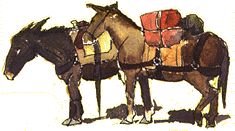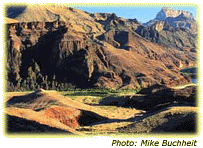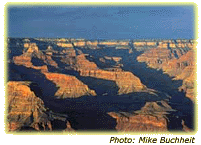 |
 |
 |
|
|||
|
Teresa: Earlier today, we dropped off the edge of the earth in a tiny helicopter and descended 2000 feet from the South Rim of the Grand Canyon to the tribal land of the Havasupai, the people of the blue water. Theirs' is a narrow canyon, lush and green from the abundant flow of Havasu Creek, and even in the glare of the full noon sun, the walls here seemed redder than anywhere else in canyon country. But now it is dark, nearly 10 o'clock at night, and the sheer rock towers above me like an inky monolith. I stand in the welcome coolness of the night while the songs of a dozen village dogs echo around me, all of us waiting for the full moon to rise over the canyon rim. The Havasupai believe that the walls of this canyon used to open and close. People were afraid to hunt and fish along the rich banks of the creek, for they might get caught in the squeeze. Then, one day, two boys sneaked away from their parents to explore, and when the walls started to contract, they shot their arrows. That stopped the walls' advance and ever since, the Havasupai have been able to live here. Now, the canyon is a bowl with very steep sides, or seems to be. As I look up at the dome of sky above, I feel at the center of things, and it humbles me to think that people stood on this same red earth to watch the moon rise hundreds of years before my own ancestors shed their fear of falling off the edge of the world and ventured this way.
More Information: The Havasupai Reservation is one of the most inaccessible places in America but it's well worth the trouble. In addition to taking one of the regularly-scheduled helicopter runs, you can get there by floating down the Colorado River, then hiking 10 miles uphill to the village. Or, from a remote spot on the South Rim of the Grand Canyon, you can descend eight miles on foot or by mule. In Supai, the tribal village, there is camping, a modest hotel and restaurant run by the tribe...and some of the most incredible waterfalls and desert walls you can see anywhere. 
Visit Hal and Teresa's web site, The Open Road.
|
 | American Public Media Home | Search | How to Listen ©2004 American Public Media | Terms of Use | Privacy Policy |

 A New Look at the Grand Canyon
A New Look at the Grand Canyon I am gazing at a low spot in the canyon rim, a jagged chip in the edge of
the bowl where the moon will first appear. The sky beyond is brightening
to a blue only a few shades darker than daylight, but I can tell that it
will be awhile before the moon breaks into view. Just as I steel myself
for a long wait, a jet flies by high overhead, its contrail pulling a
thread of moonlight out from behind the rock, stretching it clear across
the sky. The dogs go wild with delight, and so do I.
I am gazing at a low spot in the canyon rim, a jagged chip in the edge of
the bowl where the moon will first appear. The sky beyond is brightening
to a blue only a few shades darker than daylight, but I can tell that it
will be awhile before the moon breaks into view. Just as I steel myself
for a long wait, a jet flies by high overhead, its contrail pulling a
thread of moonlight out from behind the rock, stretching it clear across
the sky. The dogs go wild with delight, and so do I.